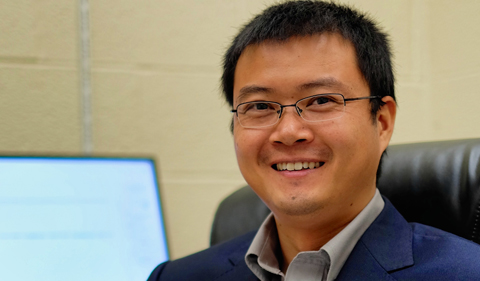By Ling Xin
NQPI Writing Intern
A recent study at the Nanoscale and Quantum Phenomena Institute (NQPI) offers new insights into the mechanism of florescence quenching, a process in which the light emitted by excited molecules goes out quickly.
By proposing that the phenomenon actually rises from intermolecular transfer rather than intramolecular rotation, the researchers challenged a generally accepted theory that has been written into textbooks for years.
When a substance absorbs light or other forms of electromagnetic radiation, its electrons will be excited to higher energy levels. To release this energy, molecules emit light in a process called fluorescence. However, the same substance can have different fluorescence behaviors under different circumstances. For instance, a type of oxazole yellow dimer nicknamed YOYO-1 appears to be very “bright” in DNA but “dark” in water under laser radiation.
This huge contrast was used to visualize DNA molecules and revolutionized the field of molecular biology in the 1990s, said Chemistry & Biochemistry Assistant Professor and NQPI member Dr. Jixin Chen, the lead researcher. The dominant explanation has been that water-immersed YOYO-1 molecules undergo internal rotation, a process that takes away the energy that otherwise would have been used in fluorescence, while those surrounded by DNA are “stuck” in the double helix structure and therefore are able to maintain continuous fluorescence.
Using super-resolution microscopy and ultra-fast laser technologies, Chen worked with Chemistry & Biochemistry Assistant Professor Dr. Katherine Cimatu, postdoctoral fellow Lei Wang and graduate student Joseph Pyle to obtain more evidence to support the traditional florescence quenching mechanism of YOYO-1 in water. If the laser-excited dyes rotate in water and relax intramolecularly, they proposed that it should be possible to measure this rotation after excitation using a blink of light that is as fast as 0.1 pico-seconds, i.e., 1/10,000,000,000,000th of a second.
To their surprise, they detected an unexpected signal that can hardly be explained by the intramolecular activities but becomes more reasonable with the long-neglected alternative theory of intermolecular fluorescence quenching mechanism: in just a few pico-seconds, the YOYO-1 appears to exchange with the solvent and acquire electrons from water molecules. This exchange leaves the molecule hotter and triggers the subsequent intramolecular rotation.
“The researchers have done a large amount of work and made significant discoveries about the excited state processes of the YOYO molecules,” commented one of the reviewers of the paper. “It is a challenging task to overturn a mature theory, even for just one molecule.”
According to Chen, the contrast of the fluorescence produced by this type of dyes in different environment is more likely due to the ability of the surrounding molecules to protect the leakage of the excited electrons, rather than the widely believed ability to stop the vibration and/or rotation of the dyes. If this mechanism is right, it will change the conventional view used to design better dyes for a variety of applications such as biolabeling, biosensing, DNA sequencing, laser, light detectors, and light emitting diodes.
Their paper, “Ultrafast transient absorption spectra of photoexcited YOYO-1 molecules call for additional investigations of their fluorescence quenching mechanism,” was published in the Journal of Photochemistry & Photobiology. Their work was supported by the National Science Foundation, the National Institutes of Health, Ohio University, and NQPI.
Abstract: In this report, we observed that YOYO-1 immobilized on a glass surface is much brighter when dried (quantum yield 16 ± 4% in the ambient air) or in hexane than in water (quantum yield ∼0%). YOYO-1 is a typical cyanine dye that has a photo-isomerization reaction upon light illumination. In order to understand this quenching mechanism, we use femtosecond transient absorption spectroscopy to measure YOYO-1’s electron dynamics after excitation directly. By deconvoluting the hot-ground-state absorption and the stimulated emission, the dynamics of electronic relaxation and balance are revealed. The results support the intermolecular charge transfer mechanism better than the intramolecular relaxation mechanism that has been widely believed before. We believe that the first step of the relaxation involves a Dexter charge transfer between the photo-excited YOYO-1 molecule and another guest molecule that is directly bound to the YOYO-1 giving two radicals with opposite signs of charges. The charges are recombined either directly between these two molecules, or both molecules start to rotate and separate from each other. Eventually, the two charges recombined non-radiatively via various pathways. These pathways are reflected on the complicated multi-exponential decay curves of YOYO-1 fluorescence lifetime measurements. This charge transfer mechanism suggests that (1) electrical insulation may help improve the quantum yield of YOYO-1 in polar solutions significantly and (2) a steric hindrance for the intramolecular rotation may have a less significant effect.



















Comments